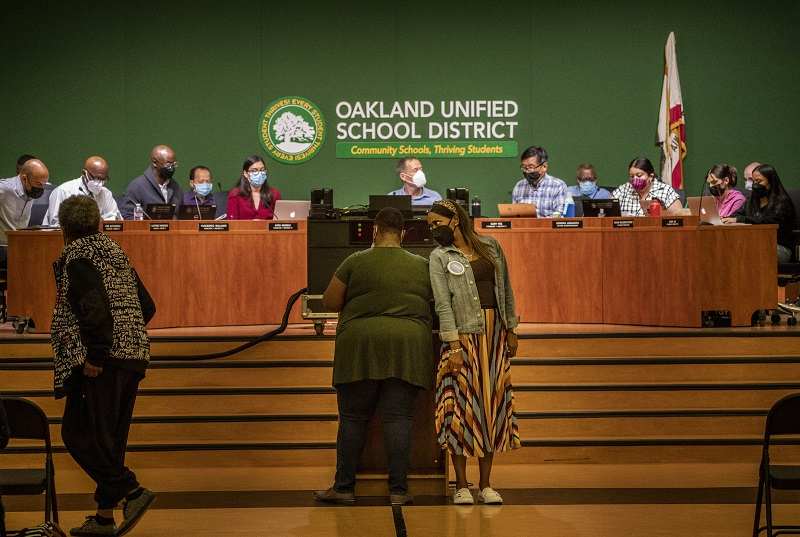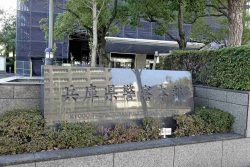
Community activist and candidate for the Oakland Unified School District School Board, Pecolia Manigo, center, listens to a fellow parent while preparing to speak to members of the Oakland Unified School District School Board during a public school board meeting in Oakland, Calif., on Aug. 24, 2022.
11:25 JST, September 19, 2022
OAKLAND – There are few sights more poignant than empty classrooms that should be full, playground basketball courts with no games, a “School Crossing” sign where there is no longer a school. Just breeze-block walls and nearly 100 years of history.
Parker Elementary School, in the words of the Oakland Unified School District, was “unsustainable,” no longer a place that drew enough children from a viable surrounding neighborhood to fill its now-dim classrooms and a dark gymnasium that had doubled as the school cafeteria. So it was shuttered last spring.
More than half the students who attended Parker were Black, kids such as Rochelle Jenkins’s 12-year-old twin daughters, Zoraya and Zariah, who navigated a few side streets to class each day. Now they walk farther, along avenues featuring stripped-to-the-rims cars and medians full of trash, to a new school with new teachers and new kids they do not yet know.
“We were devastated,” said Jenkins, a bus driver who shuttles Facebook employees to and from work each day. “We have begged them not to do this because of the ripple effect it will have on our neighborhood. This was a place that truly supported the lives of Black and Brown children.”
Oakland is closing public schools, a precise and grim measure of a city’s health. In the case of this proud city, the trend has clarified for many that Oakland, traditionally a place of radical blue-state politics, barricade-and-bullhorn protests and a grass-roots character, has fallen from vanguard to some rung far below.
Black Oakland is simply withering, overwhelmed by the steady arrival of White and Latino residents, by low Black birthrates and a cost-driven exodus, and by the uneven but pervasive gentrification transforming this city of 434,000 people.
There are not enough children to keep seven schools open after this academic year, district officials say, and it happens that the children no longer there to keep them open are predominantly Black in a city where race has defined its local identity and its national outlook for generations.
Parker Elementary, with a student body of roughly 300 children, was one of two schools that closed at the end of the last academic year. Five more will close at the end of this one, out of a total of roughly 80 campuses. Four of the seven closing schools have majority-Black student bodies. In two others, Black enrollment is disproportionately high compared with others in the district. Four other schools will partially close or merge, forcing many students elsewhere.
The Black population’s decline has been precipitous. Four decades ago, African Americans accounted for a near-majority in this city. Today Whites are the single largest racial group, followed by Latinos.
The school closures kindled persistent protest by a core group of Black parents, who occupied Parker Elementary, the only K-8 school in all of East Oakland, for much of the summer. While the spirit of resistance may endure, the campaign is over now, the school’s halls silent and stifling.
“I grew up in the shadow of the Panthers here,” said Oakland school board member Michael Hutchinson, 49, referring to the Black Panthers Party, which was founded by a pair of students who attended a local community college. Hutchinson, whose Black father and White mother met while integrating schools in the South, has opposed the district plan to close any Oakland schools.
But as an Oakland native and graduate of its public schools in which his mother taught kindergarten for four decades, he is also aware that he is part of an increasingly small group, and steeped in the city’s particularly on-the-edge brand of left-wing politics.
“There’s not many of us from here left, but it’s this constant battle,” Hutchinson said. “Are we trying to hold on to what we remember that was really good? Or are we being too resistant to change? Do we need to be more involved with what the change is?”
Nationally, similar debates are taking place from Baltimore to suburban Denver. In Southern California, the Los Angeles Unified School District, the country’s second largest, is staring down precipitous enrollment declines and considering whether school closures might be in the offing.
Here in Oakland, though, the school discussion implicates race in a way it does in few other cities. White gentrification hovers over the East Bay, even if the White population is concentrated far from Parker Elementary and the city’s rough “deep east.”
The traditional dividing line – Interstate 580 – splits the wealthy Oakland hills from the struggling “flatlands” where Parker and other affected schools are located. Much of the new housing is being built downtown where mostly White newcomers are settling, along streets that host farmers markets.
Hutchinson, the school board member, recalls that when the crack epidemic decimated the flatlands in the 1980s his mother “moved us as far up the hill as we could.” He still lives in the family home, unable to afford much else on the part-time salary of a school board member. The house a few doors down, though, recently sold for $2.4 million.
“And believe me, we’re really not that far up the hill,” Hutchinson said.
Murals of Malcolm X and Michelle Obama, Panthers founders Bobby Seale and Huey Newton, and Oaklander and former National Football League star Marshawn Lynch are ubiquitous in some neighborhoods. There is more Malcolm than Martin here, at least displayed in Technicolor paint along scruffy International Avenue and other main strips in the east.
But as the traditional community anchors of neighborhood schools and Black churches lose purchase, it is hard to see Oakland as the city it once was.
The district also has been whiplashed over the years, by education trends and population changes, leaving many schools under annual threat of closure. The district says that 35 percent of its schools have fallen to “unsustainable” enrollment levels.
“We’re on life support right now,” said City Council member Carroll Fife, who has been fighting school closures. “Because our priorities are so inverted, unfortunately, you have communities that are in the most need receiving the fewest resources.”
Fife, who is in her first term representing a fast-growing, racially mixed sector of West Oakland, sent three children through its public schools. She is among those critics of the closure plan who believe enrollment and attendance – which the state uses as factors to fund public schools – are the wrong measures and only serve to “attack the most vulnerable.”
“But people here haven’t given up,” she said.
The problems facing Oakland schools are old and new – new, that is, in the size and scope of what the board approved earlier this year in what some school officials said was an effort to stave off bankruptcy.
What has remained a constant for decades is that the school system has been inextricably tied to the region’s politics and to a sense, emanating from outside Oakland’s boundaries, that the city is unable to solve its own problems.
In 1970, the Oakland school board appointed Marcus Foster as superintendent, recruiting an educator with a record of success in Philadelphia to become one of the first African Americans to run a big-city school district.
Foster navigated the city’s volatile politics skillfully for three years, focusing on poverty, in particular, as an obstacle to education. Then, in 1973, Foster was shot eight times, dying as he departed a school board meeting.
The killing was claimed by the Symbionese Liberation Army, the group that later kidnapped heiress Patty Hearst. The group’s given reason was that Foster’s request that students get identification cards was “fascist.”
In the following decades, the African American population first rose in Oakland, then began a precipitous decline following its near-majority high in the 1980s.
By 2003, the city’s Black population had fallen to a little more than a third of the population. School district finances had declined, too.
Gary Yee, the current Oakland school board president, worked in the system for decades, rising as high as school principal, and still places flowers on Foster’s grave regularly. He also once served as the district’s interim superintendent.
“I’ve seen the expansion of programs because of enrollment demands, and I have seen the enrollment declines,” said Yee, 76, who grew up in East Oakland. “But, to be honest, there has just been a clear path of declining enrollment and, in my view, I’m not convinced that resisting gentrification is enough reason to keep a school open.”
In 2003, with the district facing a roughly $35 million budget deficit, the state Department of Education took over the operation of Oakland’s public schools, laying off hundreds of teachers and eventually shuttering more than two dozen schools. The state’s day-to-day management ended six years later, but the education department still has what is effectively veto power over fiscal decisions.
At the time of the takeover, the state extended the district a $100 million line of credit, which has yet to be paid off entirely. The district’s uncertain finances and poor performance also opened the door for experimentation from wealthy, mostly White philanthropists with no ties to Oakland.
One initiative was the “small schools” movement, financed in large part by the Bill & Melinda Gates Foundation. The idea was to break up big campuses into more intimate places for learning. The money – about $25 million before it ran out – helped open about two dozen schools. But the state administrator at the time also closed 14 others over several years.
More lasting was the charter school movement. At the time, billionaires Mike Bloomberg and the late Eli Broad spent tens of millions of dollars promoting charter schools nationally, including large sums in Oakland to support charter schools and to ensure pro-charter candidates were elected to the board.
But in a state that funds districts by student, every pupil who enrolled in a charter school meant money lost to the broader public education system.
Over the time of the state’s hands-on running of the district, more than 30 charter schools opened pulling out almost half of Oakland’s students, most of them Black and Latino, from the main public school system. The shift cost the district an estimated $57 million annually in state money.
Despite the initiatives, student performance in English and math for the last decade in Oakland’s conventional schools has lagged significantly behind those of other Alameda County districts and the state as a whole. Students enrolled in the nearly 40 charter schools operating within the district have fared little better, if at all, according to state records that are difficult for parents to navigate and hold scant historical data on performance or closures.
One charter elementary school that the state rated as “low performing,” Roses in Concrete, closed recently. It was in Parker Elementary’s Zip code.
“Oakland feels like a laboratory where people come to experiment with the latest thing,” said Pecolia Manigo, a 40-year-old single mom who has guided one child through the district schools and has two others still in them. “And navigating this as a student or parent is very, very difficult.”
Manigo has been active at Parker Elementary, where a handful of parents offered their own curriculum during their summer takeover until the district recently moved to clear them out. She is now running for school board in November, and this ballot will include enough open seats on the seven-member panel to potentially elect an anti-closure majority.
“This school didn’t have to close because of enrollment problems,” Manigo said. “This was done by the district’s approach to charters.”
The district had seemed to have recovered until, in February, district parents got a letter from Schools Superintendent Kyla Johnson-Trammell listing the seven schools scheduled for closure, including the two whose doors would shut within months.
The district’s books looked balanced. But school administrators said the black ink hid a river of future red ink as one-time spending – much of it from pandemic relief funds – disappeared. It also did not take into account an estimated $3.2 billion in necessary improvements to school buildings and the need to make teachers’ salaries more competitive.
The Oakland school district still owes the state about $30 million on the original 2003 loan, a debt that state lawmakers have declined to forgive despite a current $97 billion budget surplus and pleas from the Oakland City Council.
As the push for budget cuts began in early January, district officials initially proposed a longer list of closures, mergers and reconfigurations. But the board whittled it down under parent pressure. Some Zoom meetings at the time drew more than 2,000 people, many of them people of color protesting the plan.
Oakland allows parents to pick their district schools provided there is space on campuses outside their assigned enrollment area. But the district does not provide bus service to students, making it nearly impossible for working parents to pick schools far from home.
For parents and students, still infused with the protest politics of historic Oakland, the decisions on what schools to close and why are unsatisfying. By the district’s analysis, the changes affect 36 percent of African American students and only 6 percent of the White student body, a stark ratio given Oakland’s recent efforts to focus attention on the dire needs within Black schools.
Following George Floyd’s 2020 murder by police in Minneapolis, the board eliminated the Oakland school police force, redirecting the millions of dollars a year to youth programs. And in March 2021, the board passed a resolution calling for reparations for Black students, citing two decades of “school closures in Black neighborhoods and the gentrification it has spurred, the over-criminalization of Black youth, and the failure to adequately resource schools serving black families.”
The resolution also committed the board to “identify and invest” in historically Black schools where 40 percent or more of enrolled students are Black – criteria Parker Elementary fit. Yet it was closed a year after the resolution was approved.
“The passing of the resolution was an acknowledgment that you have caused harm,” said Manigo, who was involved in the reparations movement. “But it also means you stop creating harm going forward.”
Rochelle Jenkins’s twins now walk downhill along 98th Avenue to get to their new school, Elmhurst United Middle School.
Where the walk gets frightening is when the girls come to the intersection with MacArthur Boulevard, which despite the hopeful streetlight banners declaring “Black Love Is Alive a Vibe” is an unwelcoming strip of mostly empty storefronts and busy smoke shops.
The two faced nothing like it on their walk to Parker, nor have many others from the school’s student diaspora. Violent crime is rising in Oakland – overall the city is on pace to surpass its homicide rate of last year – and the “deep east” is a fraught place to let children out on the streets alone.
Late last month, 9-year-old Black student Juanaeh Newton, 4-foot-7 and 100 pounds, got lost on his way home from his new school after years at Parker Elementary. He was disoriented, then flustered. Police issued a community bulletin and soon, frightened but safe, Newton was found.
Jenkins tracks her girls by cellphone during stops along her route dropping off Facebook employees. She said she does it relentlessly.
“Now my kids get to walk through a war zone to get to school,” she said. “Just because we live in a low-income neighborhood doesn’t mean we sit around twiddling our thumbs.”
"News Services" POPULAR ARTICLE
-

American Playwright Jeremy O. Harris Arrested in Japan on Alleged Drug Smuggling
-

Japan’s Nikkei Stock Average as JGB Yields, Yen Rise on Rate-Hike Bets
-

Japan’s Nikkei Stock Average Licks Wounds after Selloff Sparked by BOJ Hike Bets (UPDATE 1)
-

Japan’s Nikkei Stock Average Buoyed by Stable Yen; SoftBank’s Slide Caps Gains (UPDATE 1)
-

Japanese Bond Yields Zoom, Stocks Slide as Rate Hike Looms
JN ACCESS RANKING
-

Keidanren Chairman Yoshinobu Tsutsui Visits Kashiwazaki-Kariwa Nuclear Power Plant; Inspects New Emergency Safety System
-

Imports of Rare Earths from China Facing Delays, May Be Caused by Deterioration of Japan-China Relations
-

University of Tokyo Professor Discusses Japanese Economic Security in Interview Ahead of Forum
-

Japan Pulls out of Vietnam Nuclear Project, Complicating Hanoi’s Power Plans
-

Govt Aims to Expand NISA Program Lineup, Abolish Age Restriction






















